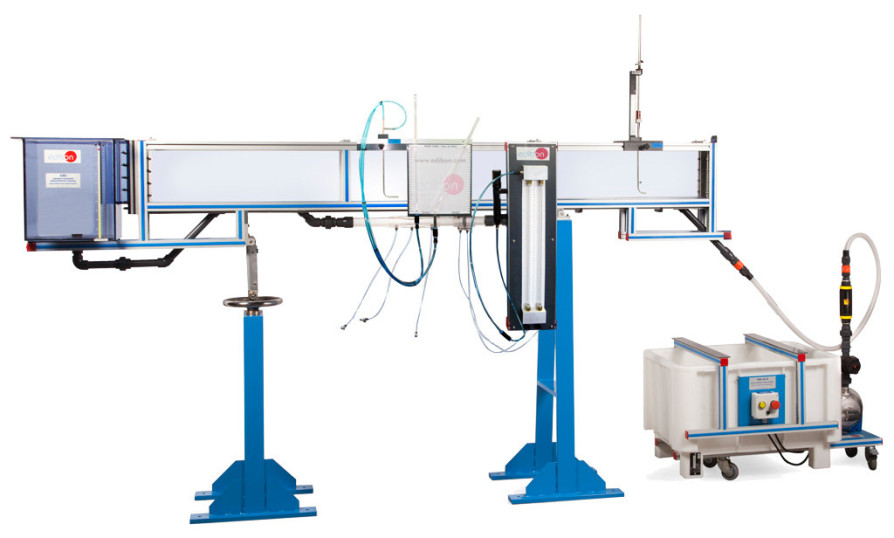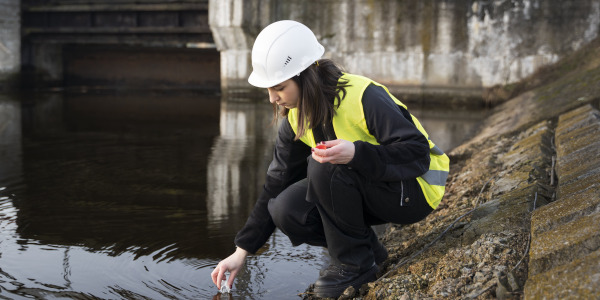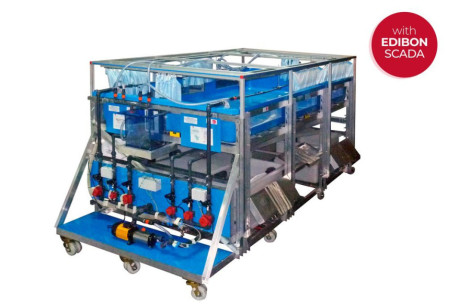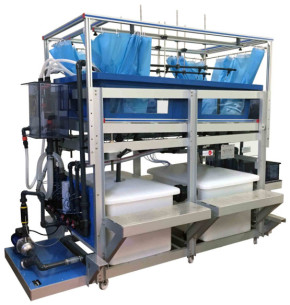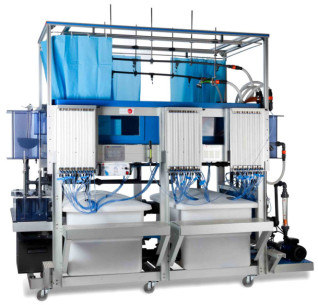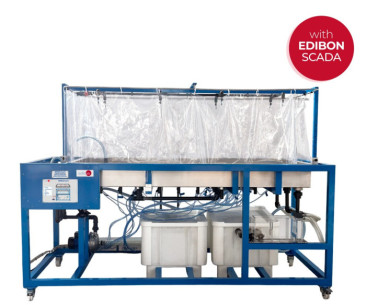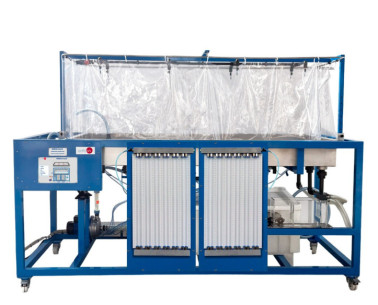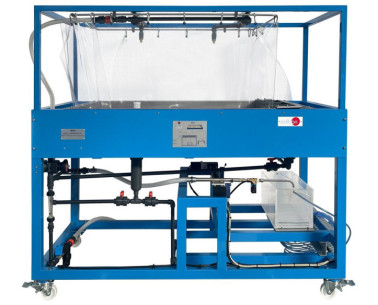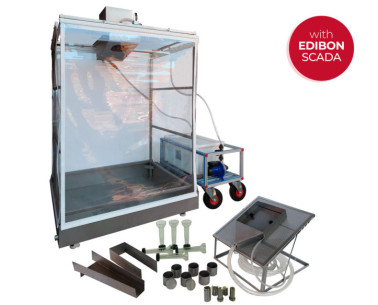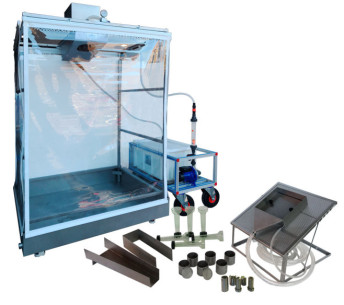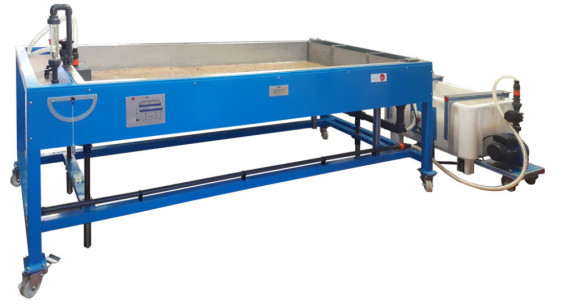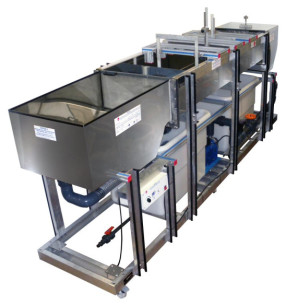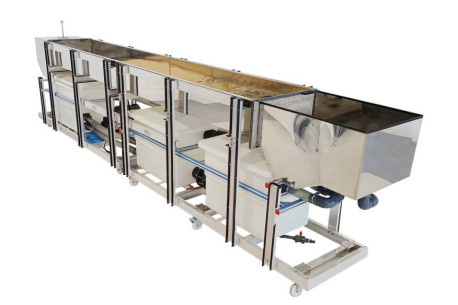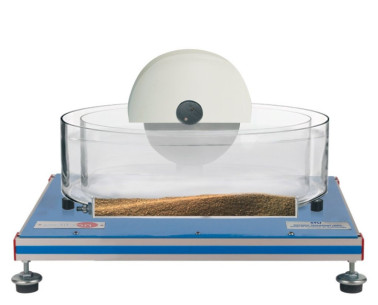CAS 개방형 침전 채널
혁신적인 시스템
The Sediment Transport Demonstration Channel, "CAS", designed by EDIBON, allows demonstration of the full range of bedforms that arise in a mobile bed as the slope and / or flow are increased.
실험실
관련 뉴스
일반적인 설명
The Sediment Transport Demonstration Channel, "CAS", designed by EDIBON, consist of an inclinable channel mounted on a base plate, supported by two supports, with a discharge tank and recirculating pump. This tank is in the Basic Hydraulic Feed System (FME00/B) that contains the recirculating pump.
The channel sides are transparent allowing the observation of bed profile changes, and a section of one side is provided with graphical grid markings to permit quantitative assessments to be made of bedform dynamics.
A water level gauge is included to measure the head over the channel discharge weir and therefore to deduce flow rates from a calibration chart. For demonstrating scour effects of structures on rivers beds, solids models, as an adjustable undershot weir and bridge pier are supplied.
To start a demonstration, sand is placed along the channel bed, between the inlet tank and the overfall discharge weir. Water is circulated around the system at one of the flow rates. The slope of the channel is adjustable.
연습 및 가이드
매뉴얼에 포함 된 가이드 실기 연습
Flow over a mobile sand bed:
Bedforms associated with increasing flow intensity and sediment transport rate:
- Lower regime (bedforms exhibed):
- Plane bed (no motion).
- Ripples and dunes.
- Washed out dunes.
- Ripples.
- Dunes.
- Upper regime (bedforms exhibed):
- Plane bed (with motion).
- Chutes and pools.
- Anti dunes.
- Breaking anti dunes.
- Standing waves.
Flow over fixed, gravel bed:
- Although the channel can not transport gravel, this can be used to investigate flow resistance in gravel and polder bed rivers.
- We can calculate the flow resistance coeficients, using equations such as those of Bray, Limerinos, Hey, Lacey, Thompson and Campbell and Bathurst and the results compared to the actual values obtained by observation.
Flow structures:
- We can examine the structure of turbulence in the flow using dye injection, interesting for the dune bedform configuration and clearly demonstrates separation on the lee face.
Fixed, smooth bed flow:
The channel may be used without sediment on the bed to demonstrate several flow phenomena and equations:
- Rapid, super critical flow dominance of intertial over gravity forces, shock waves from flow obstructions.
- Turbulence.
- Governing equations of open channel flow Reynold’s number, Froude number, continuity, Bernoulli’s equation, weir equations.
- Tranquil, sub critical flow movement of surface waves upstream against flow.
- Hydraulic jump transition from super to sub critical flow, air entrainment, mixing.
- Flow measurement using sharp crested weirs.
Bedform hysteresis:
- If the discharge in the channel changes quickly, there is no sufficient time for bedforms to adjust to the new flow regime. Hence, if a flood hydrograph is simulated by increasing and then decreasing the discharge, different depths will occur for the same discharge on the rising and falling limbs.
Data collection and numerical evaluation (computational work):
- In addition to illustrating flow and sediment phenomena, we can use the channel for basic data collection and numerical evaluation of the following:
- Flow resistance.
- Manning, Chezy and Darcy-Weisbach fricion factors for several bedform configuration.
- Bedform prediction.
- Velocity Hjulstrom diagram.
- Suspended load movement by suspension.
- Shields parameter Bogardi diagram.
- Stream power Simons and Richarson charts.
- Boundary shear stress Leeder chart.
- Initiation of motion.
- Shields diagram.
- Hjulstrom’s curve.
Mechanics of sediment transport:
- We can observe the movement of grains, starting from a plane bed with no motion, on the following:
- Initiation of motion.
- Trajectory of initial motion.
- Movement by rolling and sliding (contact load).
- Movement by hopping (saltation load).
- Movement by suspension.
Depositionary features and facies:
- We can observe the deposition of sediment load and the resulting patterns of grains within the sand body may be identified.
Local scour:
- Scour under boils and vortices in the flow is observed under both the lower and upper regime bedforms. Obstructions may be introduced to represent bridge piers, sills, revetments, etc, and the resulting pattern of scour examined.
장비로 수행 할 수있는 더 많은 실용적 연습
- Behaviour study of the connection to the drain of a channel with sendiment.
- Turbulence study by means coloration.
- Calculation of water flow.
보완 장비
Computer Controlled Hydrologic Systems, Rain Simulator and Irrigation Systems Unit (2x1 m)
Hydrologic Systems, Rain Simulator and Irrigation Systems Unit (2x1 m)
Computer Controlled Hydrologic Studies Unit
Hydrologic Studies Unit
Rainfall Hydrographs Unit
토양 침식 연구용 강수 시뮬레이터, 컴퓨터 제어 (PC)
토양 침식 연구용 강수 시뮬레이터
강 유량 시뮬레이터
Mobile Bed and Flow Visualization Unit (working section: 2000X610 mm)
Mobile Bed and Flow Visualization Unit (working section: 4000x610 mm)
퇴적물 운송 장비
품질

판매 후 서비스

 쿠키 기본 설정
쿠키 기본 설정

